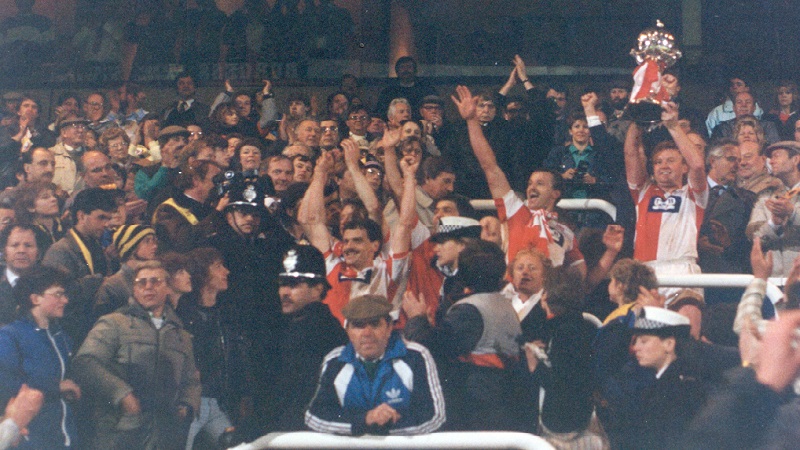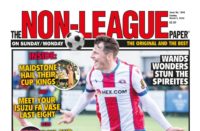GOOD TIMES: Kidderminster Harriers lift the FA Trophy in 1987. Picture: Kidderminster FC
By Chris Dunlavy
Messi, Suarez and Neymar. Mane, Firmino and Salah. The modern game has seen some sensational attacking trios.
But when it comes to sheer numbers, none holds a candle to the Kidderminster Harriers line-up that terrorised the Alliance in the 1980s.
Kim Casey, Paul Davies and Mick Tuohy have gone down in legend at Aggborough, largely thanks to a remarkable 1985-86 campaign that yielded a combined total of 139 goals.
Tuohy got 22. Davies 44. And Casey – who nominally played on the right wing – bagged a scarcely credible 73 goals in 68 matches.
“It was unbelievable thinking back,” says Davies, now 59 and a coach at West Midlands League side Bewdley Town.
“As a team, we scored over 200 goals in all competitions and there were some incredible scorelines. We were winning five and six on a regular basis.
“I spent 15 years at Kidderminster and had some great times. We won the league, played at Wembley, won the FA Trophy. But when I see fans in the street, that season is always the thing they want to talk about. The goals, the excitement, the football we played – it was unforgettable.”
Such staggering figures are at least partly explained by the number of fixtures Kiddy played. As well as contesting the 22-team Alliance, Harriers featured in – deep breath – the Staffordshire Senior Cup, the Welsh Cup, the Bob Lord Trophy, the TSB Trophy, the Mitchells and Butlers Cup, the FA Trophy and the FA Cup.
The same XI started almost every one of those 76 matches, the equivalent of two full Premier League seasons.
Of greater significance, however, was the gung-ho philosophy of pioneering manager Graham Allner.
A man who made Kevin Keegan look conservative, Allner had little interest in clean sheets. In 1985-86 alone, Kiddy beat Wycombe 8-2, lost 8-3 to Runcorn and averaged over four goals per game.
At opposition corners, Casey, Davies and Tuohy were all left upfield. “Opposing clubs couldn't believe it,” laughs Davies, more commonly known by the nickname Ocker.
“They'd go up for corners, then suddenly realise us three were stood on the halfway line. You could see the panic set in!
“You might think I'm exaggerating but in 15 years I never went in my own penalty area. Not once. Graham just wouldn't allow it.”
Allner also deployed inverted wingers before Cristiano Ronaldo was even born, and utilised a high-pressing 4-3-3 when Jurgen Klopp was still working in a Frankfurt video store.
“People don't believe it when you tell them,” adds Davies. “They think that Klopp has invented something completely revolutionary. But we were doing it 35 years ago. We watch that Liverpool team now and it's old hat to us.
“Because that high press was the whole basis of our game. The only difference was that we called it closing down. As forwards, our job was to win the ball up the pitch and that's what we did. The number of chances we created was incredible.”
Chances, though, need to be put away. And in Casey, Davies and Tuohy, Allner had assembled a strikeforce that turned his vision into an exhilarating reality.
Davies, a local boy who'd briefly played in the Football League for Cardiff, marginally predated Allner's arrival from rivals Leamington in 1983.
Tuohy, the eldest of the three and an established Non-League striker with Worcester City, was the next to arrive.
His prowess as a central targetman liberated the equally muscular Davies to play the ‘Ronaldo' role on the left, and when Allner paid former club Leamington £2,500 for 24-year-old Casey in July 1985, the jet-heeled sniffer slotted in on the right.
“We all had different skills and we complemented each other incredibly well,” says Tuohy, now 64. “Technically, the others were far superior to me.
“Kim was very, very fast with a tremendous strike. You talk about predatory strikers who sniff out chances and he was the epitome of that. He was great in the six-yard box.
“Paul was strong, very skilful and had that ability to cut inside and muscle past people. My strengths were back to goal and bringing others into play. I basically used to shovel the ball off to those two because they were much better finishers than I was!”
Understanding was instant, training minimal.
“We didn't work on playing together,” admits Davies. “All we really practised was the shape and the pressing. If you got that right, you'd create so many chances that it was inevitable somebody would score.”
So it proved. Kidderminster began the 85-86 season with wins of 4-1 and 5-0, ended it with that 8-2 demolition of Wycombe and, somewhere along the way, inflicted a 10-1 defeat on Welsh side Chenk AAA. By the end of the season, they had scored 203 times.
“It was a remarkable time,” says Tuohy. “And as a forward it was an absolute delight to play in that team. It was always entertaining. Always the emphasis on scoring goals. Everywhere we went, we'd put 100 people on the gate.”
Nobody pulled in the punters like Casey, whose 73-goal haul included six hat-tricks and seventeen braces.
“I couldn't have done it without those two,” insists Casey, who set a club record that still stands today. “And that's not me being modest. Micky was very unselfish in the way he played. Ocker could beat anyone. I just picked up the bits.
“We also had defenders and midfielders who got forward and put balls in the box. For a striker, it was paradise. I wouldn't have five chances in a game, I'd have 20. I missed far more than I scored, but it didn't matter. I'd always get more.”
Inevitably, the absurd numbers coming out of Aggborough attracted attention. Wolves, Cardiff and Walsall all made approaches for Davies, whilst Casey was a target for several Football League clubs, including Doncaster Rovers. Neither were tempted.
“I have no doubt at all that both Kim and Paul would have scored lots of goals in the Third or Fourth Division,” says Tuohy. “But they were both sensible enough to be in positions where they didn't need to turn professional and were actually very happy – and well off – playing at the highest level in Non-League.”
Kiddy finished that season third in the Alliance behind Enfield and Frickley. Tellingly, Allner's men had outscored every team in the division yet shipped more goals than 16th-placed Northwich Victoria.
“People pay to come and watch football,” says Tuohy. “And whilst they like to see their team victorious, they want to be entertained. They want to see goals and we gave them that.”
Davies adds: “We didn't win the league, but we got to the Welsh Cup final, the quarter-finals of the FA Trophy, we had all these fantastic games and scorelines. Really, it was just the start of us becoming one of the foremost names in Non-League.”
Indeed, Kiddy would win the FA Trophy a year later, Davies grabbing both goals in a 2-1 win over Burton at the Hawthorns.
Casey, too, eclipsed his previous season's league tally by netting 38 times in the newly-named Conference to collect consecutive golden boots.
As a trio, though, their days were numbered. During a game at Welling in early 1988, Casey broke his leg in two places.
“I think it was January or February when it happened,” he recalls. “I got married in the June and the plaster had just come off. I could hardly even walk down the aisle! Long-term, it didn't hinder me. I actually won the double with Wycombe a few years later. But it was quite a long recovery and getting back from an injury like that isn't easy, especially in those days.”
By the time a fully healed but far from match-fit Casey returned, Allner was already constructing the side that would win the Conference title in 1994. Davies remained, but Tuohy and Casey were sold to Cheltenham in 1990. The goal-den days were over.
“Good things only last for so long,” says Casey. “In life and in football. That's why you have to make sure you enjoy them and, to be fair, we did. It was a great, great group. Ocker was instrumental. Micky was sensational. My memories of that club are fabulous – they always will be.”
Davies adds: “I'm still big mates with Kim and Mick. We've had a few get-togethers over the years. We had a great team spirit, good laughs.”
There is, of course, one aspect of that fabled season which may live forever – Casey's incredible 73-goal haul.
“Well, they said that about Billy Boswell, whose record I took,” he says. “That had stood since 1936 and he was actually in the crowd the day I beat it.
“A part of me would like it to stand. But if it meant Kidderminster got into the League then I'd be happy to stand there like Billy and see it smashed.”
Kiddy's season in numbers:
Games: 76
Goals For: 203
Goals Against: 114
Avg Goals per game: 4.1
Number of times Kiddy scored 4+ goals: 21
Biggest win: 10-1 v Chirk AAA (h)
Biggest defeat: 8-3 v Runcorn (a)
Top Scorers:
Kim Casey: 73
Paul Davies: 44
Mick Tuohy: 22
For much more news make sure you get your copy of The Non-League Paper this week!
In shops on Sundays and Mondays, The NLP is also available as a page-rustling digital edition and full replica of the printed paper from midnight on Saturdays.
Try the digital paper for free today with our first paper in May only a few clicks away right now as a FREE SAMPLE EDITION! Digital readers also save cash on single issues, even more on longer deals and enjoy full access to The NLP's entire archive.
Have you voted yet in the 2020 National Game Awards with the polls closing on tonight? Click here today to cast your vote in single or multiple categories in this season's ‘Virtual NGAs'!
The Non-League Paper is also a finalist in the 2020 Football Content Awards. Help The NLP win one of football's Oscars by voting today via the accolades' website or social media platforms.
To vote via the website click here
To vote via Twitter click here
To vote via Instagram click here
Images courtesy of The Non-League Paper






















